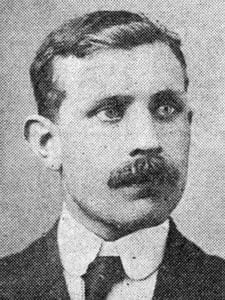Albert Johan Moss was born 14 December 1882 at Schrodersmug 8, Bergen, Norway to Edvard Wilhelm, b. 21 December 1846, and Dorothea (née Andersdatter; born 15 February 1850) Moss – they had married 20 October 1872 at the cathedral of the Church of Norway in Bergen, Hordaland.
He had several brothers and sisters including Bernhard Alexander, b. 4 December 1872, Hjalmar Nicolai, b. 12 August 1876, Carl, b. 11 August 1877, Catharina Mathilde, b. 6 March 1874, Arthur Wilhelm, b. 6 June 1890, Öivind, b. 3 October 1888, and Agnes, b. 18 December 1889.
Moss initially worked in optician Nilsen's shop in Bergen. In June 1899, however, he got employment on a ship and later attended navigation school and received his ship's officer's certificate in June, 1910.
In September 1911 he became first officer on the Norwegian cargo ship S. S. Hebe, belonging to the Harloff & Rödseth Company.
Albert Moss was first officer on board the Hebe as it steamed fom a Swedish port in the Baltic to Preston on the west coast of England. Outside Preston, Lancashire, Albert and the rest of the crew at SS Hebe fell victim to a dramatic shipwreck on the 11th of December. The ship was crushed against the cliffs, but fortunately the entire crew was rescued by a lifeboat from nearby Southport. Albert returned to Bergen just in time to celebrate Christmas with his siblings.
Moss boarded the Titanic at Southampton with Knud Rommetvedt and Hans Birkeland. They were travelling to join the SS Norheim (also belonging to the Norwegian company Harloff & Rödseth) then docked at Philadelphia, Moss was to be first officer1.
Moss survived the sinking of the Titanic but gave contradictory accounts of how he escaped. In some, he claimed to have leapt from the side of the ship and swum to a lifeboat, in others he was simply selected to man a lifeboat on account of his seafaring experience.
'...Moss said he was standing among other passengers watching the women being placed in the boats, when the mate of the Titanic singled him out and asked whether he was a seafaring man. Receiving an affirmative answer, the officer commanded him to man one of the boats.' (Delaware County Daily Times /Chester, Delaware/, 24 April 1912, p. 9)
''A survivor of the Titanic tragedy came to port yesterday in the person of Chief Officer Foss [sic] of the Norwegian sugar boat Norheim, which arrived from San Domingo with a large cargo of sugar late Saturday. With an engineer, J. P. Petersen, formerly of the Norheim, Foss leaped over the side as the Titanic began to settle. For three hours he swam and floated on the icy water before he was picked up. His companion was drowned.'' (Boston Herald, May 26, 1913, p. 5)
'...Moss said he was standing among other passengers watching the women being placed in the boats, when the mate of the Titanic singled him out and asked whether he was a seafaring man. Receiving an affirmative answer, the officer commanded him to man one of the boats.' (Delaware County Daily Times, Chester, Delaware, 24 April 1912, p. 9)
From the Red Cross files: No. 320. (Norwegian) Ship's officer, 29 years old, coming to take position on vessel bound for West Indies, lost clothing, navigation instruments and some money. He was given a sextant, which enabled him to take his intended work. ($48)
After two weeks at a hospital in New York he continued to Philadelphia and onboard Norheim as planned. Later on he was appointed captain at another Norwegian steamer Nordkyn. Although Norway was not a part of WW1, Nordkyn was torpedoed off Morocco. Albert and all the crew members managed to enter the lifeboats and reached a Moroccan town after three days.
Safely home in Bergen he married his own niece Ingrid, the daughter of his elder brother Bernhard. He then had a ten-year long pause from his seafaring life, and Ingrid and Albert had three children Gunvor, Egil, and Reidun; the latter later married to Håkon Bertelsen and had five children.
In 1930 Albert returned to sea in coal transport from Spitzbergen to Germany. This continued until 1941 when the coal steamers were transferred from Spitzbergen via Iceland to Scotland. Here he took over as a captain at S/S Munin in freight along the British coasts until June 1944. Then Albert and Munin were engaged in the freight of ammunition and other goods during the invasion of Normandy for the rest of WW2.
Eventually, in January 1946 he was allowed to return to Bergen and meet again with family and friends. There he lived a long and quiet life as a pensioner together with Ingrid, children and grandchildren until his death on 4 July 1973. Although he gave some interviews to radio and newspapers, Albert did not like to speak about his experiences at sea, neither the Titanic disaster nor other of his sinister experiences.
Albert Johan Moss is buried in Bergen General Cemetery, Noord-Holland, Netherlands (plot SO.E10.7.9).



Comment and discuss
Open Thread Leave a Reply Watch Thread